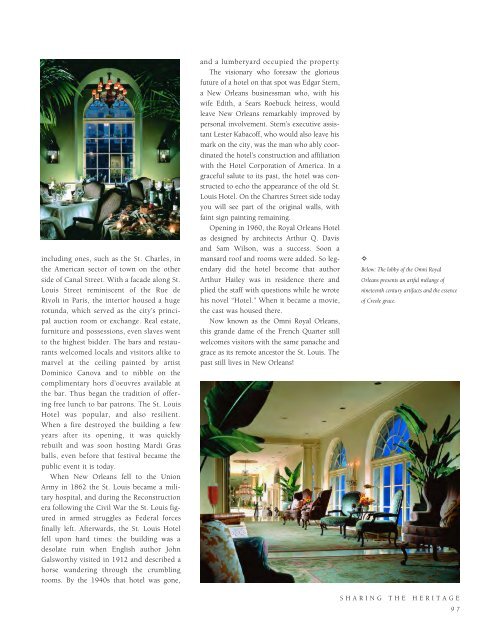Historic Louisiana
An illustrated history of Louisiana, paired with the histories of companies, families and organizations that make the state great.
An illustrated history of Louisiana, paired with the histories of companies, families and organizations that make the state great.
You also want an ePaper? Increase the reach of your titles
YUMPU automatically turns print PDFs into web optimized ePapers that Google loves.
including ones, such as the St. Charles, in<br />
the American sector of town on the other<br />
side of Canal Street. With a facade along St.<br />
Louis Street reminiscent of the Rue de<br />
Rivoli in Paris, the interior housed a huge<br />
rotunda, which served as the city’s principal<br />
auction room or exchange. Real estate,<br />
furniture and possessions, even slaves went<br />
to the highest bidder. The bars and restaurants<br />
welcomed locals and visitors alike to<br />
marvel at the ceiling painted by artist<br />
Dominico Canova and to nibble on the<br />
complimentary hors d’oeuvres available at<br />
the bar. Thus began the tradition of offering<br />
free lunch to bar patrons. The St. Louis<br />
Hotel was popular, and also resilient.<br />
When a fire destroyed the building a few<br />
years after its opening, it was quickly<br />
rebuilt and was soon hosting Mardi Gras<br />
balls, even before that festival became the<br />
public event it is today.<br />
When New Orleans fell to the Union<br />
Army in 1862 the St. Louis became a military<br />
hospital, and during the Reconstruction<br />
era following the Civil War the St. Louis figured<br />
in armed struggles as Federal forces<br />
finally left. Afterwards, the St. Louis Hotel<br />
fell upon hard times: the building was a<br />
desolate ruin when English author John<br />
Galsworthy visited in 1912 and described a<br />
horse wandering through the crumbling<br />
rooms. By the 1940s that hotel was gone,<br />
and a lumberyard occupied the property.<br />
The visionary who foresaw the glorious<br />
future of a hotel on that spot was Edgar Stern,<br />
a New Orleans businessman who, with his<br />
wife Edith, a Sears Roebuck heiress, would<br />
leave New Orleans remarkably improved by<br />
personal involvement. Stern’s executive assistant<br />
Lester Kabacoff, who would also leave his<br />
mark on the city, was the man who ably coordinated<br />
the hotel’s construction and affiliation<br />
with the Hotel Corporation of America. In a<br />
graceful salute to its past, the hotel was constructed<br />
to echo the appearance of the old St.<br />
Louis Hotel. On the Chartres Street side today<br />
you will see part of the original walls, with<br />
faint sign painting remaining.<br />
Opening in 1960, the Royal Orleans Hotel<br />
as designed by architects Arthur Q. Davis<br />
and Sam Wilson, was a success. Soon a<br />
mansard roof and rooms were added. So legendary<br />
did the hotel become that author<br />
Arthur Hailey was in residence there and<br />
plied the staff with questions while he wrote<br />
his novel “Hotel.” When it became a movie,<br />
the cast was housed there.<br />
Now known as the Omni Royal Orleans,<br />
this grande dame of the French Quarter still<br />
welcomes visitors with the same panache and<br />
grace as its remote ancestor the St. Louis. The<br />
past still lives in New Orleans!<br />
✧<br />
Below: The lobby of the Omni Royal<br />
Orleans presents an artful mélange of<br />
nineteenth century artifacts and the essence<br />
of Creole grace.<br />
SHARING THE HERITAGE<br />
97
















